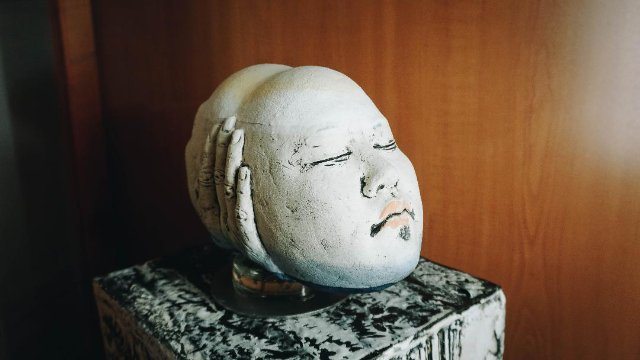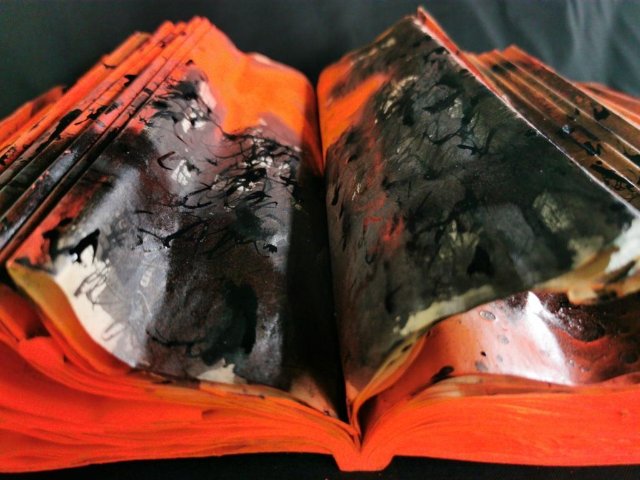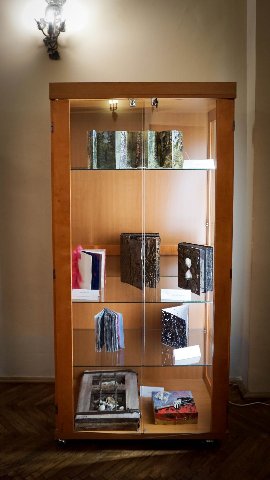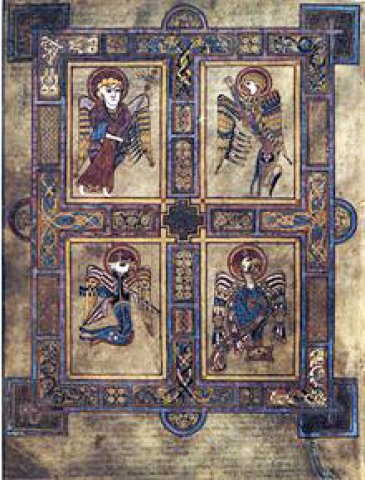5th EIBAB Book Art Biennial, 2020
And a Short History of Artists Books
By: Astrid Hiemer - Nov 06, 2020
Beginning with a short history of the Book as Art, we will then highlight the 5th EIBAB European International Book Art Exhibition of 2020, which was held in September in the Karolyi Castle of Carei, Transylvania, Romania. It was organized by the Association of Professional Visual Artists DFEWA, Dresden, Germany, and supported by the Culture Department of Carei Municipality and the Center for the Promotion of Cultural Tourism ‘Grof Karolyi.’ The driving force behind these Biennials is Dorothea Fleiss, curator of this show.
Millenia old scrolls have been excavated and preserved on different Continents. However, bound books were first created in monasteries throughout Europe. They were exquisite texts on very soft skins, or papyri and hand-bound by wooden boards, covered in leather, and perhaps decorated with precious stones.
Medieval artist-monks created The Book of Kells in the 9th Century, for example. We were fortunate enough to experience it at Trinity College Library, Dublin, Ireland, some ten years ago. The magnificent illustrations or illuminations of Christ, the Virgin, the four evangelists, and colorful, exquisite Celtic designs were enlarged and hanging framed lit in one exhibition space, while visitors with great reverence would step up into another room, darkened, in order to view the rather small in size book. It is also known as The Book of Columba after the monastery where it was created. It was actually rebound and -sized in the 19th Century. The Book on 680 pages reveals in Latin primarily the Four Gospels of the New Testament of Mathew, Mark, John and Luke. What an indelible experience to actually get close to the Millennial old scriptures. We learned that the book is opened up daily to another page or section, in order to prevent further deterioration. Lucky, we were spared many hours in long lines of waiting visitors during Summer months. Our memorable trip to Ireland occurred in the Fall.
Also, we had already been introduced to the Sarajevo Haggadah via a spell-binding novel by Geraldine Brooks. This particular Haggadah was created around 1350 in Barcelona, still shows wine stains, which indicates that it was actually used during Passover Seder celebrations. It is handwritten on calfskin with exquisite illuminations in gold and copper. The Haggadah was smuggled out of Spain by Sephardic Jews leaving Spain in 1492, because of the Alhambra Decree that expelled them. Over the Centuries this Haggadah found rescuers of all faiths and was finally sold to the National Museum in Sarajevo, Bosnia, at the end of the 19th Century, hence its current name. Yet, the manuscript was hidden from the Nazis and Ustasha (Croatian Fascists) in a mosque during World War II and still survived a break-in during the Siege of Sarajevo (Bosnian War) during the 1990s. It was left by thieves on the floor, discarded as not valuable. Today, on permanent exhibition in Sarajevo it has also been included in the UNESCO Memory of the World Register.
Modern or contemporary artists books begin with the early 20th Century, yet William and Catherine Blake created individual books, printed in text with images, hand colored, then bound, already a couple of Centuries prior. The best known would be: Songs of Innocence and of Experience.
Artists expressed their views or political positions widely throughout Europe in posters, pamphlets and unique books and by various self-distributions. There were the Italian Futurists; the Russian Futurists, later Constructivists; Dada movement in Switzerland; the Bauhaus in Germany; De Stijl in the Netherlands.
Post WW II, the book form again turned into highly individual expressions. Perhaps, the most extreme was an entire pulped book, then mixed with spices, and stuffed by Dieter Roth into natural hog casings: Literature Sausage - and Fluxus, became a movement in Europe and the USA and included Georg Brecht, Joseph Beuys, Daniel Spoerri, Yoko Ono and Nam June Paik among others in the 1960s-70s.
Through the decades of the last Century, artists also produced books that were printed in small editions and were also sold in all sorts of venues and not in galleries, by necessity or by choice. Ed Ruscha sold his first book Twentysix Gasoline Stations, 1963, originally in the gas stations that he photographed on his way from California to his parents’ home in Oklahoma. The first edition sold four hundred books.
It was not until the 1960s -70s that the artist’s book was accepted as an Artistic Discipline. In fact, it has currently been declared as the fastest growing discipline in the US by such an organization as the Center for Book Arts, in New York City. There are now an estimated 100,000 practitioners in North America and perhaps even greater numbers elsewhere in the world.
That leads to the 5th EIBAB Book Art Exhibition: 135 artists submitted their work from 19 countries in Europe, Russia, and other Continents: North and South America, Morocco, Thailand and Myanmar. The EIBAB website had called for submissions, organized in a well-defined process. A good number of book art practitioners have repeatedly participated in these Biennials.
The Carolyi Castle, of course, proved to be a splendid exhibition space. Visitors to the show also enjoyed touring the castle and vice versa, so that the exhibition received a larger audience. Approximately 20 participating artists came to the open-air vernissage on September 3rd from near and far to this regionally important city, which is also a tourist attraction.
The 2020 Biennial’s guiding theme was: Book as r/evolution - and so we wondered, how the artist’s book has evolved in the last decade? Fleiss suggests that: “The idea ‘book’ has changed in the past years, but the artists books are not changed so much, the diversity is infinity. In this edition, maybe it was the first artist book – with electronically use – with a Display by Corneliu Baba…”
Please refer to the above photo series. Artist’s books appear to have moved further away from words or texts. They have become more sculptural or extreme 3-dimensional in size. A series of origami folded paper spiders or bugs were exhibited in a deep floater frame and so were (Cafea) coffee house menus and related documents, also sporting a slice of white bread. Mary Kritz declared: ”We can only be wise with wisdom of our own." A hopeful piece announced "Das Buch der Freundschaft," "The Book of Friends" in several languages. One work stood tall as a contemporary vellum scroll. Then, there were several very imaginative accordion books and repurposed books. The works were very colorful!
EIBAB awarded prizes to participants: The Grand Prix went to Arina Ailincai. Her piece can be seen in our above photo series. A double faced head rests on a short square pedestal with inscribed texts. As noted earlier by Fleiss, the Award for Innovation went to Dorin Baba for Flash Memory. The ‘computer board’ shows a window in the center, to where? Actually, Baba also uploaded a series of digital images in the window that 'flash memory' when activated. Finally, further prizes went to young and student artists.
These more than 100 works were beautifully exhibited in cases or on tables, where a few could be touched with gloved hands only. All visitors were wearing masks, also in Romania Covid-19 demands protective gear. The show closed on September 18.
EIBAB is an established ten-year-old organization, which has actually already sponsored or promoted nine book art exhibitions in Romania, the USA, Russia, India and Japan with changing curators. Fleiss, the founder of the organization, relies on international established venues and manages, based on her own name and reputation, to introduce the Art of the Book to ever widening global audiences.
Now, Fleiss and her small group of collaborators are already making plans to show the EIBAB Collection in 2021 at the Havana Biennial in Cuba.
One question remains: Will any of the 20th or 21st Century artist’s books survive and perhaps have the allure or reverence a hundred or even one-thousand years from now?





















